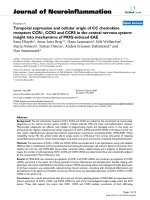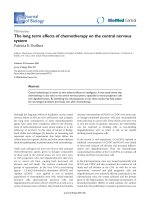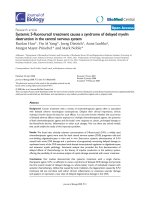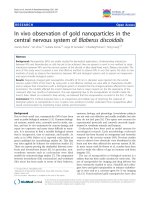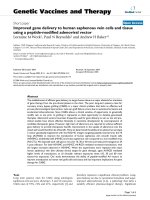Genetic engineering and surface modification of baculovirus derived vectors for improved gene delivery to the central nervous system
Bạn đang xem bản rút gọn của tài liệu. Xem và tải ngay bản đầy đủ của tài liệu tại đây (2.39 MB, 172 trang )
GENETIC ENGINEERING AND SURFACE
MODIFICATION OF BACULOVIRUS DERIVED
VECTORS FOR IMPROVED GENE DELIVERY TO THE
CENTRAL NERVOUS SYSTEM
YANG YI
NATIONAL UNIVERSITY OF SINGAPORE
2006
GENETIC ENGINEERING AND SURFACE
MODIFICATION OF BACULOVIRUS DERIVED
VECTORS FOR IMPROVED GENE DELIVERY TO THE
CENTRAL NERVOUS SYSTEM
YANG YI
(B. Eng.)
A THESIS SUBMITTED
FOR THE DEGREE OF DOCTOR OF PHILOSOPHY
GRADUATE PROGRAMME IN BIOENGINEERING
NATIONAL UNIVERSITY OF SINGAPORE
AND
INSTITUTE OF BIOENGINEERING AND NANOTECHNOLOGY
July 2006
ACKNOWLEDGMENTS
First and foremost, I wish to express my appreciation to my supervisor, Dr.
Wang Shu, Associate Professor, Department of Biological Science, National
University of Singapore; Group Leader, Institute of Bioengineering and
Nanotechnology, for his continuous support and patient guidance. And to my
co-supervisors,
Dr.
Feng
Si-shen,
Associate
Professor,
Division
of
Bioengineering, National University of Singapore, for the in-depth discussions
and useful suggestions.
I would also like to acknowledge our exceptional research group at Institute
of Bioengineering and Nanotechnology for providing such a fabulous
environment for the study.
Special acknowledgments go to Dr. Li Ying, Dr. Liu Beihui, and Dr. Wu
Chunxiao for their assistant in my research project, and to Dr. Jurvansuu
Jaana for the critical review of the manuscript.
This thesis is dedicated to my father Yang Zhoumou and my mother Peng
Liying, whose love, encouragement and support have always been my
greatest impetus.
I
TABLE OF CONTENTS
Contents
Page
Acknowledgments………………………………………………………………….I
Table of Contents……………………………………………………………….....II
Summary…………………………………………………………………………...VI
List of Publications……………………………………………………...……...VIII
List of Tables.................................................................................................IX
List of Figures……………………………………………………………………...X
Abbreviations…...………………………………………………………………...XII
Chapter One: Introduction………………………………………………….1
1.1 General Introduction………………………………………………………….2
1.1.1 Gene Therapy……………………………………………………………..2
1.1.2 Non-viral and Viral Gene Delivery Systems……………………………2
1.1.3 PEI and Its Role in Gene Delivery……………………………………....3
1.1.4 Viral Gene Delivery to the CNS..........................................................6
1.1.5 Baculovirus Vectors Mediated Gene Delivery………………………..10
1.2 Purpose of This Study………………………………………………………12
1.3 Specific Objectives…………………………………………………………..13
Chapter Two: Production, Characterization and
Purification of Baculovirus Particles……………..15
2.1 Introduction…………………………………………………………………...16
2.1.1 Baculovirus and the Insect Cell Expression System…………………16
2.1.2 Recombinant Baculovirus Vectors for Gene Delivery…..….….........19
2.1.3 Production and Purification Related Issues………………………..…20
2.1.4 Objectives………………………………………………………………...20
2.2 Materials and Methods……………………………………………………...21
2.2.1 Production of Recombinant Baculovirus Particles…………………...21
2.2.2 Viral Stock Amplification………………………………………………...24
2.2.3 Viral Particles Purification and Concentration………………………..24
2.2.4 Titering of Viral Stocks…………………………………………………..25
II
2.2.5 Electron Microscopy……………………………………………………..27
2.2.6 Particle Size and Surface Charge Measurements…………………...27
2.2.7 Cell Lines and Cell Culture……………………………………………..28
2.2.8 Cell Transduction………………………………………………………..28
2.2.9 Luciferase Expression Measurement………………………………….28
2.2.10 Flowcytometric Studies………………………………………………….29
2.3 Results…………………………………………………………………………29
2.3.1 The Potential of Baculovirus as a Vector for
CNS Gene Delivery In Vitro…………………………………………….29
2.3.2 Studies of Baculovirus Particles Production Procedure……………..36
2.3.3 Studies of Baculovirus Particles Purification and
Concentration Procedures……………………………………………...41
2.3.4 Studies of Physical Characteristics of Baculovirus Particles………..45
2.3.5 Baculovirus Particles Interacting with Charged Membrane
and a New Purification Method………………………………………...51
2.4 Discussions…………………………………………………………………..60
Chapter Three: Genetic Engineering of Baculovirus
Vectors for Controlled Gene Delivery…………65
3.1 Introduction…………………………………………………………………...66
3.1.1 Genetic Engineering of Baculovirus Vectors for Neuron-targeted
Gene Delivery…………………………………………………………….66
3.1.2 Hybrid Promoter with CMV Enhancer………………………………….68
3.1.3 Artificial Transcriptional Factor Boosted Gene Expression………….69
3.1.4 Objectives…………………………………………………………………70
3.2 Improved Neuronal Gene Delivery Achieved by the Adoption
of a Hybrid Promoter………………………………………………………..70
3.2.1 Materials and Methods……………………………………………………70
3.2.1.1 Construction of pGL3-based vectors for promoter
strength comparison…………………………………………………70
3.2.1.2 Construction of recombinant baculovirus vectors………………...71
3.2.1.3 In vitro gene delivery studies………………………………………..72
3.2.1.4 In vivo gene delivery studies………………………………………..72
III
3.2.1.5 Immunofuluoresence studies………………………………………..73
3.2.2 Results……………………………………………………………………..73
3.2.2.1 Neuronal Promoters Display Lower Activities Than
Commonly Used Viral Promoters…………………………………...73
3.2.2.2 Improved In Vitro Gene Delivery Mediated by the
Hybrid Promoter Baculovirus Vector………………………………..76
3.2.2.3 Enhanced In Vivo Gene Delivery Mediated by the
Hybrid Promoter Baculovirus Vector………………………………..80
3.2.2.3 Neuronal Specificity of In Vivo Gene Delivery Mediated
by the Hybrid Promoter Baculovirus vector………………………..82
3.2.3 Discussions………………………………………………………………..85
3.3 Artificial Transcriptional Factor Boosted Neuronal Gene Delivery
Driven by PDGF Promoter………………………………………………….86
3.3.1 Materials and Methods……………………………………………………89
3.3.1.1 Construction of recombinant baculovirus vectors…………………89
3.3.1.2 In vitro gene delivery studies………………………………………...89
3.3.1.3 In vivo gene delivery studies………………………………………...90
3.3.2 Results……………………………………………………………………..91
3.3.2.1 In Vitro Studies of the Recombinant Transcriptional Activation….91
3.3.2.2 In Vivo Studies of the Recombinant Transcriptional Activation….96
3.3.3 Discussions………………………………………………………………101
3.4 Summary……………………………………………………………………..104
Chapter Four: Surface Modification of Baculovirus for
Improved In Vivo Gene Delivery…………….…...106
4.1 Introduction………………………………………………………………….107
4.1.1 Susceptibility of Baculovirus to Complement Inactivation………….107
4.1.2 Baculovirus Surface Modification……………………………………..108
4.1.3 Objectives………………………………………………………………..108
4.2 Materials and Methods…………………………………………………….109
4.2.1 Preparation of Baculovirus Particles………………………………….109
4.2.2 Preparation of BV-PEI Complex Particles……………………………109
4.2.3 Characterization of BV-PEI Complex Particles………………………110
IV
4.2.4 Serum Complement Inactivation of BV-PEI Vectors………………..110
4.2.5 Cytotoxicity Assay………………………………………………………110
4.2.6 Electron Microscopy…………………………………………………….111
4.2.7 In Vitro Transduction and Gene Expression Assay…………………111
4.2.8 In Vivo Gene Delivery Studies………………………………………...111
4.3 Results……………………………………………………………………….112
4.3.1 Baculovirus Particles Interact with PEI Polymers…………………...112
4.3.2 Transduction Capabilities of BV-PEI Vectors………………………..119
4.3.3 Surface Modification of PEI25k Protect BV Particles
against Serum Complement Attack…………………………………...121
4.3.4 In Vitro Studies of BV-PEI25k Vector Mediated Gene Delivery……124
4.3.5 Cytotoxicity of BV-PEI25k Particles…………………………………..129
4.3.6 In Vivo Studies of BV-PEI25k Vector Mediated Gene Delivery……131
4.4 Discussions…………………………………………………………………137
Chapter Five: Conclusion………………………………………………..140
5.1 Results and Implications………………………………………………….141
5.1.1 Preparation and Characterization of Baculovirus Particles…………141
5.1.2 Genetic Engineering of Baculovirus Vectors for Controlled
Gene Expression………………………………………………………...142
5.1.3 Surface Modifications of Baculovirus Vectors for Improved
In Vivo Gene Delivery…………………………………………………...143
5.2 Conclusion…………………………………………………………………..144
References…………………………………………………………………….145
V
SUMMARY
The studies presented in this thesis focused on development and
modification of baculovirus-based vectors in order to achieve improved gene
delivery to the Central Nervous System.
There are many important requirements for an ideal gene delivery system,
including
feasible
vector
production
procedure,
regulated
transgene
expression, and satisfactory in vivo gene delivery performance. Our studies
focused on improving all these three aspects.
First, we studied the gene delivery capability and physical characteristics of
baculovirus, as well as several important issues related to baculovirus vector
production and purification processes. A new baculovirus purification method
utilizing charged membrane filters was developed and evaluated.
Second, through genetic engineering of baculovirus vectors, we achieved
targeted gene delivery with enhanced and controlled transgene expression
specifically in neuronal cells. Two different promoter designs, utilizing a hybrid
promoter and a transcriptional activator, were employed to achieve improved
transgene expression, both in vitro and in vivo.
Last, a baculovirus surface modification technique based on electrostatic
interactions was developed. By incorporating PEI polymers onto the surface
of baculovirus particles, we developed a virus-based complex vector which is
VI
more resistant to the serum inactivation. Our studies demonstrated that
improved in vivo gene delivery performance of baculovirus-based vectors
could be achieved through this surface modification.
In summary, the information gained from our research, such as
development of modified vectors and evaluation of pertinent methods, should
contribute to the development of Central Nervous System gene therapies as
well as to the progression of various virus- and gene delivery-related studies.
VII
LIST OF PUBLICATIONS
Publications:
1. Y Li, Y Yang, S Wang. Neuronal gene transfer by baculovirus-derived
vectors
accommodating
a
neurone-specific
promoter.
Experimental
Physiology, v. 90, p. 39-44, 2005
2. CY Wang, F Li, Y Yang, HY Guo, CX Wu, S Wang. Recombinant
baculovirus containing the diphtheria toxin a gene for malignant glioma
therapy. Cancer Research, 1:66 (11) 5798-5806, 2006
3. BH Liu, Y Yang, JFR Paton, F Li, J Boulaire, S Kasparov and S Wang.
GAL4-NFkappaB Fusion Protein Augments Transgene Expression from
Neuronal Promoters in the Rat Brain. Molecular Therapy, in press, 2006
Manuscript:
Y Yang, CX Wu, S Wang. Surface Modification of Baculovirus for Improved In
Vivo Gene Delivery. 2006
The studies presented in this thesis are based on the research work in the
above publications and manuscript.
VIII
LIST OF TABLES
Table
Page
Table 3.1 Vectors used for promoter strength comparison…………………...74
Table 3.2 Plasmid and baculovirus vectors used in the study………………..92
IX
LIST OF FIGURES
Figure
Page
Figure 1.1 Structures of PEI precursors and end products………………..…5
Figure 2.1 Life cycle of ‘budded’ baculovirus…………………………………17
Figure 2.2 Expression cassette of BV-CMV-Luc/eGFP……………………...22
Figure 2.3 Schematics of baculovirus production procedure………………..22
Figure 2.4 Map of pFastBacTM plasmid………………………………………23
Figure 2.5 Typical plaque assay results……………………………………….26
Figure 2.6 Baculovirus can transduce an array of cell lines…………………30
Figure 2.7 Luciferase expressions of baculovirus transduced
glioma cells…………………………………………………………..32
Figure 2.8 Baculovirus transduction efficiencies on glioma cells. ………….34
Figure 2.9 Gene delivery capabilities of virus stocks produced
with different replicating MOI………………………………………38
Figure 2.10 Gene delivery capabilities of virus stocks produced
with different incubation time for replication……………………...40
Figure 2.11 Gene expression activity of BV particles after filtration…………42
Figure 2.12 Gene expression activities of BV particles after
centrifugation-resuspension processes…………………………..44
Figure 2.13 TEM image of baculovirus virions…………………………………47
Figure 2.14 TEM image of enveloped baculovirus particles………………….48
Figure 2.15 Baculovirus particle size……………………………………………50
Figure 2.16 Baculovirus surface charge………………………………………...50
Figure 2.17 Baculovirus particles interact with positively
charged membrane…………………………………………………52
Figure 2.18 Baculovirus particles interact with negatively
charged membrane…………………………………………………54
Figure 2.19 Concentration of baculovirus particles using
negatively charged membrane filter……………………………….56
Figure 2.20 Purify and concentrate baculovirus particles
using negatively charged membrane……………………………..59
Figure 3.1 Comparison of promoter strength in neuronal cells……………..75
Figure 3.2 Luciferase activity in C17.2 cells after BV transduction…………77
X
Figure 3.3 Luciferase activity in primary rat cerebellar granule
neurons after transduction of BV-PDGF-Luc,
BV-CMV E/PDGF-Luc or BV-CMV E/P-Luc……………………...79
Figure 3.4 Dose-dependent effects of baculovirus vectors
on gene expression in rat striatum……………………………81
Figure 3.5 Confocal images of luciferase expression in rat striatum…..83
Figure 3.6 Confocal images of luciferase expression in rat retina……..84
Figure 3.7 Baculovirus vector with two-step transcriptional activation……..88
Figure 3.8 GAL4p65 enhances the activity of PDGF promoter in a
neuron-specific manner…………………………………………….94
Figure 3.9 Plasmid- and baculovirus vector-mediated GAL4p65
expression augments gene expression from the PDGF
neuronal promoter in rat brain in vivo………………………...98
Figure 3.10 Neuronal specificity as demonstrated by
immunohistochemical analysis of rat brains……………………100
Figure 4.1
Characterization of BV-PEI25k particles……………………….114
Figure 4.2
Baculovirus interacts with PEI with different
molecular weights………………………………………………….117
Figure 4.3
Transduction capability of PEI-modified
baculovirus vector…………………………………………………120
Figure 4.4
PEI25k protects virus particles against serum
complement attack……………………………………………….123
Figure 4.5
Transduction capabilities of BV-PEI particles with serum
complement inactivation………………………………………….125
Figure 4.6
PEI25k can not rescue transduction of serum complement
inactivated BV……………………………………………………..127
Figure 4.7
Cytotoxicity of BV-PEI particles…………………………………130
Figure 4.8
Mice tail vein injection of BV-PEI25k……………………………133
Figure 4.9
Tail vein injection of BV-PEI25k into tumor-implanted
nude mice………………………………………………………….135
Figure 4.10 Intratumor injection of BV-PEI25k particles…………………….136
XI
ABBREVIATIONS
AAV
AcMNPV
adeno-associate virus
Autographa californica nuclear polyhedrosis
virus
Ad
adenovirus
BV
baculovirus
CAG
cytomegalovirus enhancer/chicken β actin
promoter
CMV
CMV E
cytomegalovirus
enhancer of cytomegalovirus immediate-early
gene
CMV E/P
CNS
DI
cytomegalovirus enhancer/promoter
central nervous system
deionized
DMEM
Dulbecco’s modified eagle’s medium
eGFP
enhanced green fluorescent protein
FBS
fetal bovine serum
GAL4 BD
GAL4 DNA-binding domain
GAL4 BS
GAL4 DNA-binding sequence
HSV
herpes simplex virus
ITR
inverted terminal repeat
LTR
long terminal repeat
XII
Luc
luciferase
MAC
membrane attack complex
MOI
multiplicity of infection
MCS
multiple cloning site
NeuN
antibody against neuron-specific nuclear protein
NFқB
nuclear factor-kappaB
PBS
phosphate-buffered saline
PDGF
human platelet-derived growth factor
PEI
polyethylenimine
Pfu
plaque forming unit
Psi
packaging signal
RLU
relative light units
RSV
Rous sarcoma virus long terminal repeat
promoter
siRNA
SV
small interfering RNA
Simian virus
SYN
human synapsin I promoter
TEM
transmission electron microscope
VSVG
vesicular stomatitis virus G glycoprotein
XIII
CHAPTER 1
INTRODUCTION
1
1.1 General Introduction
In spite of rapid advancement of biomedical science and technology, a
number of complicated diseases still remain incurable. Many of these
unconquered diseases such as Central Nervous System (CNS) disorders,
including complex neurodegenerative disorders and brain cancers with poor
prognosis, are found correlated to defects of certain genetic components.
Hence, gene therapy emerges as a promising approach to provide efficient
treatment for these difficult diseases.
1.1.1 Gene Therapy
The main concept of gene therapy is to use genetic materials to replace or
restore function of the missing, abnormal or malfunctioning gene components,
thus cure the diseases or relieve the symptoms. Two key issues that need to
be addressed for gene therapy will be “what kind of genetic materials should
be
used”
and
“how
to
implement
the
therapeutic
functions”.
The
implementation part, known as gene delivery, is particularly critical because
challenges in this process are currently the major hurdles that keep most of
gene therapies remain in the experimental stage. In order to overcome these
hurdles and achieve successful implementations, the main focus of gene
delivery studies is to develop and modify vectors that can carry, transport and
execute functions of the therapeutic genes.
1.1.2 Non-viral and Viral Gene Delivery Systems
Depending on the usage of vectors, there are two main types of gene
delivery systems: non-viral and viral systems. Large amounts of studies have
2
demonstrated that non-viral materials such as cationic polymers (Lungwitz et
al., 2005), lipids (Martin et al., 2005) , proteins, and peptides (Gupta et al.,
2005) can be used as vectors to mediate gene delivery. The advantages of
using non-viral systems, including ease of manipulation, large transfer
capacity and less pathogenic risk, have continuously encouraged researchers’
endeavour. However, the low efficiency of non-viral gene delivery remains a
critical drawback of the system. On the other hand, viral gene delivery
systems are favoured because of the high efficiency of infective viral vectors.
Many types of viruses have been demonstrated to possess potent gene
delivery capabilities, including Herpes Simplex Virus (Maguire-Zeiss et al.,
2001), Adeno-Associated Virus (Jooss and Chirmule, 2003), Adenovirus (St
George, 2003) Retrovirus, and Lentivirus (Sinn et al., 2005), etc.
In the following section, one of the most commonly used non-viral vectors,
namely polyethylenimine (PEI), and several major types of viral vectors that
have been employed particularly for CNS gene deliveries will be introduced.
1.1.3 PEI and Its Role in Gene Delivery
Among non-viral gene carriers in use, the polycationic polymer, PEI, has
shown high transfection efficiency both in vitro and in vivo (Boussif et al.,
1995;Abdallah et al., 1996b;Goula et al., 1998b). As shown in Figure 1.1, PEI
comes in two forms: linear and branched. The branched form is produced by
cationic polymerization from aziridine monomers via a chain-growth
mechanism, with branch sites arising from specific interactions between two
growing polymer molecules. The linear form of PEI also arises from cationic
3
polymerization, but from a 2-substituted 2-oxazoline monomer instead. The
product (for example linear poly(N-formalethylenimine)) is then hydrolyzed to
yield linear PEI (Godbey et al., 1999c). PEI has repeated basic units with a
backbone of two carbons followed by one nitrogen atom and contains primary,
secondary, and, in the case of branched PEI, tertiary amino groups, each of
which has the potential to become protonated.
The branched form of PEI has yielded significantly greater success in terms
of cell transfection, and is therefore the standard form of PEI for gene delivery.
Highly branched polymers such as the 25 kDa and the 800 kDa molecular
weight PEI polymers are most frequently used for gene delivery (Fischer et al.,
1999).
PEI
mediates
transfection
via
condensing
DNA
into
nanoparticles/complexes, protecting DNA from enzymatic degradation, and
facilitating cell uptake and endolysosomal escape of the PEI-DNA complex.
PEI polymers are able to effectively complex even large DNA molecules
(Campeau et al., 2001), leading to homogeneous spherical particles with the
sizes of 100 nm or less, which are capable of transfecting cells efficiently in
vitro as well as in vivo.
4
Figure 1.1 Structures of PEI precursors and end products. *Aziridine can
also yield linear PEI under certain conditions (Godbey et al., 1999b).
5
PEI has been used as an efficient CNS gene delivery vector by several
groups. Feltz group successfully transfected primary central and peripheral
neurons with antisense oligoneucleotides complexed by PEI (Lambert et al.,
1996). High transfection efficiency was achieved in mature mouse brain by
using PEI/DNA complex with PEI molecular weights of 25, 50 and 800 kDa
(Abdallah et al., 1996a). PEI with molecular weight of 25 kDa (PEI25k) was
the most efficient one, in comparison with 50 and 800 kDa PEI. Following
these reports, many experiments have been done by using PEI for CNS gene
delivery with different molecular weight, by different injection pathway, and
with different modifications (Goula et al., 1998c;Tang et al., 2003;Shi et al.,
2003).
1.1.4 Viral Gene Delivery to the CNS
Viral vectors have attracted attention in the field of gene delivery, because
of their high transduction efficiencies that seem to be unreachable for nonviral gene delivery systems. There are several types of viral vectors that are
commonly used for CNS gene delivery:
Herpes simplex virus type 1 (HSV1) is a common pathogen in humans
causing primarily cold sores but occasionally encephalitis and other lifethreatening conditions, especially in immune-compromised individuals. HSV is
an enveloped virus which carries a double-stranded DNA of 152 kb. HSV has
a high infectivity in neurons and glia cells, as well as several other cell types
(Frampton, Jr. et al., 2005). HSV vectors are delivered by rapid retrograde
transport along neurites to the cell body (Sodeik et al., 1997;Bearer et al.,
6
1999), providing a means of targeting gene transfer to neuronal cells that is
difficult to reach directly.
Adeno-associated virus (AAV) is a non-pathogenic small virus (20–24 nm
in diameter), which contains a single-stranded DNA genome. AAV-based
vectors have a 4.5 kb transgene cloning capacity (Muzyczka, 1992) and
inverted terminal repeats (ITRs) that promote extrachromosomal replication
and genomic integration of the transgene (Xiao et al., 1997). The integration
of transgenes delivered by AAV vectors can be either random or site-specific
into human chromosome (Kotin et al., 1990;Weitzman et al., 1994;Yang et al.,
1997;Balague et al., 1997;Walther and Stein, 2000). The specificity and
stability of transgene expression from AAV vectors seems to be dependent of
the brain area and the presence of receptors for AAV uptake on target cells.
AAV-based vectors can produce high levels of transgene expression after
injection into the CNS, and this transgene expression is predominantly in
neurons (Kaplitt and Makimura, 1997;Bartlett et al., 1998;Mandel et al.,
1998;Lo et al., 1999).
Adenovirus (Ad) is another famous gene delivery vector. The first
generation of replication-defective Ad vectors proved to have limited use in
gene therapy, mainly due to a strong host immune response to the viral
antigens (Yang et al., 1994;Dai et al., 1995). Recently, high-capacity ‘gutless’
or ‘mini-chromosome’ Ad vectors have been generated that retain only the
sequences necessary for packaging and replication of the viral genome, but
lack all structural genes (Fisher et al., 1996;Kochanek et al., 1996;Hardy et al.,
7
1997). These modified vectors provide increased transgene cloning capacity
(up to 37 kb) and safer high titer propagation methods using a Cre-lox based
recombinase system instead of helper Ad virus (Hardy et al., 1997). In vivo
studies have shown prolonged expression of transgenes delivered by these
vectors with low host inflammatory response (Lieber et al., 1997;Morsy et al.,
1998;Kumar-Singh and Farber, 1998). Even in the presence of peripheral
infection with adenovirus, there is virtually no immune response in the brain
following direct injection of “gutless” vectors in rats. However, the high
antigenicity of the Ad virion and toxicity of the virion penton proteins remain as
potential complicating factors with this vector system.
Retrovirus vectors are derived primarily from Moloney murine leukemia
virus (MoMLV) (Mulligan, 1993). Retroviruses are enveloped RNA viruses
which can transfer genes to a wide spectrum of dividing cell types. The
vectors bear up to 8.5 kb of transgenes flanked by retroviral long terminal
repeat (LTR) regions, a virion packaging signal (psi), and a primer binding site
for reverse transcription. Retroviral RNA within the cell is reverse transcribed
into double-stranded DNA which can then integrate randomly into the host cell
genome. The use of retrovirus vectors for gene delivery to the nervous system
has been limited by their ability to transfer genes only to dividing cells,
although they are well suited for on-site delivery to neural precursors for
lineage studies (Cepko et al., 2000), to tumor cells for therapeutic intervention,
and for ex vivo gene transfer.
8
Lentivirus is a well known member of the retrovirus family. The main
advantage of lentivirus-based vectors is their ability to integrate into the host
genome of both dividing and nondividing cells, thereby providing the potential
for a delivery system with stable expression even in post-mitotic neurons
(Naldini et al., 1996c). The restricted host range, low titers, and pathogenic
characteristics of the vector, itself, limit its utility as a gene delivery system for
the CNS. In an effort to retain the positive attributes of lentivirus and produce
a safer and more versatile gene delivery system, the vector is pseudotyped
with the vesicular stomatitis virus G glycoprotein (VSVG), broadening the host
range to include brain, liver and muscle cells (Naldini et al., 1996a;Naldini et
al., 1996b;Kafri et al., 1997;Zufferey et al., 1997).
When employing infective viruses, risks due to their pathogenicities and
immunogenicities are relatively high, thus extra cautions must be given to the
safety issues. One of the strategies to circumvent these problems is to use
viruses from non-human origins for human gene delivery. Without pre-existing
immunity, human bodies could be less alert or resistant to the vectors, and
thus the gene delivery could be safer while retaining high efficiency (Loser et
al., 2002). Furthermore, viral vectors from other origins may be non-replicative
in human body, in which case they are more controllable and have reduced
risk in the gene therapy applications.
In the following section, one type of viral vectors derived from the insect
origin, namely baculovirus, will be introduced. Accumulated reports have
shown that a wide range of cells and tissues are susceptible to baculovirus
9
infection; the resulting transgene expression levels are relatively high; Thus, a
good potential of baculovirus vector in gene delivery have been demonstrated.
1.1.5 Baculovirus Vectors Mediated Gene Delivery
Baculoviruses (family Baculoviridae) constitute a group of double stranded
DNA viruses that cause lethal diseases of arthropods. A member of the family,
Autographa californica nuclear polyhedrosis virus (AcMNPV), has been most
commonly used in various researches; Hence it becomes the best studied
baculovirus. This AcMNPV baculovirus is a large enveloped virus with a
double-stranded, circular DNA genome of ~130 kb (Ayres et al., 1994).
Researchers reported that recombinant vectors derived from this baculovirus
could efficiently transduce different types of cells, such as hepatic, pancreatic,
kidney and neural cells, from different species including rodents, primates and
human. High expressions of the delivered genes could be observed after
successful transductions (Boyce and Bucher, 1996;Condreay et al.,
1999;Sarkis et al., 2000). These observations indicated that recombinant
baculovirus could be a powerful vector that is useful for various types of gene
therapies. On the other hand, baculoviruses are non-replicative in mammalian
cells; it makes the gene deliveries mediated by baculovirus vectors easier to
be controlled. The large DNA size of baculovirus can provide a large capacity
for the transfer of genetic materials. Moreover, production and manipulation
processes of recombinant baculoviruses are relatively easy, so that large
scale preparation would be feasible (Ghosh et al., 2002;Kost and Condreay,
2002). These intrinsic advantages would highlight baculovirus as a very
promising gene delivery vector.
10
